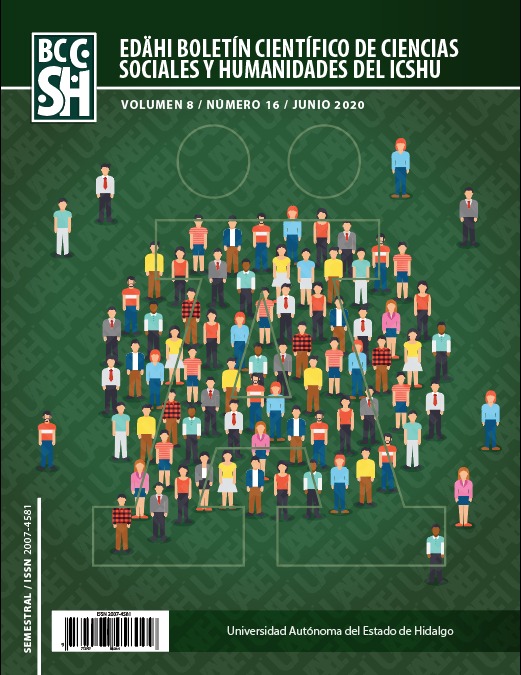Campaigns against gender violence: the media in the construction of a social imaginary in young people in upper secondary education
Abstract
The present work argues that the visual representations created for social advertising campaigns to prevent and address gender violence, affect the conformation of a collective imaginary about violence, which type gender violence into physical violence, separating it from a cultural problem and creating a non-attacked us and the other victims. The foregoing is based on the social advertising review to address and prevent gender-based violence both in Mexico and in the analysis with the categories of Roland Barthes, of the images created by middle school youth, during focus group sessions applied to them, during 2014, in the city of Pachuca, Hidalgo in Mexico. The main conclusions point to the fact that young people state that they have little proximity to the campaigns issued by civil institutions or associations, and that in many cases they do not feel identified with the images or slogans, yet they shape their imaginary about gender violence, without realizing it from the social advertising they consume.
Downloads
References
Agudelo, Pedro Antonio (2011). “(Des)hilvanar el sentido/los juegos de Penélope” Uni- pluri/versidad, Vol.1, Núm.18.
Barthes Roland (1982/1986) Lo obvio y lo obtuso. Imágenes, gestos y voces. Buenos Aires: Paidós Comunicación.
Castelli, Azul Kikey (2019). Las huellas del discurso. Publicidad social y violencia de género. México: Universidad Autónoma del Estado de Hidalgo.
El país. Campaña fallida. La sucesión de crímenes de violencia de género casa mal con un anuncio en el que el concepto de malos tratos va asociado a unas mujeres sonriendo. 7 de Agosto de 2019. https://elpais.com/elpais/2019/08/07/opinion/1565201895_689582.html [último acceso: 1 de Septiembre de 2019].
Escobar, Jazmine, y Bonilla-Jiménez, Francy Ivonne (2009). “Grupos focales: una guía conceptual y metodológica”. Cuadernos hispanoamericanos de psicología. Vol. 9, Nun. 1, pp-54-65.
Fernández, Ana María (2016). “La imaginación colectiva y anónima”. Diferencias. Revista de teoría social contemporánea. No.2, Año 2, mayo 2016, pp.194-213.
Fernández, Diana (2008). “Gramáticas de la publicidad sobre la violencia: la ausencia del empoderamiento tras el ojo morado y la sonrisa serena”. Feminismo/s. Núm.11, junio, 2008, pp. 15-39.
Hovland, Carl, Arthur Lumsdaine y Fred Sheffield. (1985) “Efectos a corto y a largo plazo en el caso de los films de «orientación» o propaganda”. En Moragas, Miquel. Sociología de la comunicación de masas. I Escuelas y autores, pp. 238-251. Barcelona: Gustavo Gili.
Kitzinger, Jenny (1995). “Qualitative Research: Introducing focus group”. Qualitative Research: Introducing focus group. 29 de Julio de 1995, fecha de consulta: 20 de enero de 2014. http://www.bmj.com/content/311/7000/299.
Krueger, Richard (1994). Focus Group: a principal guide for applied research. Estados Unidos: Newbury Park CA.
López Lita, Rafael y Bernad, Estela (2007), “Publicidad, medios de comunicación y segregación ocupacional de la mujer: perpetuación y superación de los estereotipos de género y sus consecuencias en el mercado de mano de obra”. Revista del Ministerio de Trabajo y Asuntos Sociales, Núm. 67, pp. 213-225.
Piñeiro M. Teresa (2010). “Estereotipos femeninos en la publicidad: la utilización del sexolecto como un atributo caracterizador”. Cuadernos Kóre. Revista de historia y pensamiento de género. El género en controversia. Rocío Orsi (ed.). Vol. 1, Nº 2. Primavera 2010, pp. 156-178.
Martínez Portugal, Tania (2017). Transformando imaginarios sobre violencia sexista. País Vasco: Emakunde.
Onwuegbuzie, Anthony J., Wendy B. Dickinson, Nancy L. Leech, y Annmarie G. Zoran. (2011). “Un marco cualitativo para la recolección y análisis de datos en la investigación basada en grupos focales”. Paradigmas, ene.-jun., 2011, Vol. 3, No. 1, pp. 127-157.
Ramírez, Miguel Ángel (2011). “Grupos focales”. Revistas de negocios, pp. 70-74. file:///C:/Users/USUARIO/Downloads/Miguel%20%C3%81ngel%20Ram%C3%ADrez___CESUN%20Universidad%20maramirez@cesun.edu.mx.pdf
Staff, Indigo. Cambio de percepción. 8 de Septiembre de 2013. https://www.reporteindigo.com/reporte/cambio-de-percepcion/.













